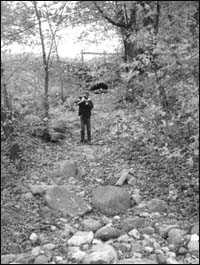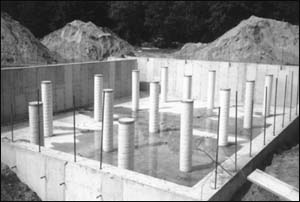
Conservation practices being implemented by farmers and lake home owners are helping in the effort to clean up Lake Koronis and Rice Lake.
ďConservation works when everybody works together,Ē Patrick Corrigan, Sauk Rapids, said. Corrigan of Land Care Environmental Services has worked with the North Fork Crow River Watershed District (NFCRWD) on several projects.
Among the projects implemented this year was a manure management storage facility on the Dennis Fink farm near Rice Lake, sediment control basin structures on the Vince Miller and Tony Eull property, shore line stabilization on the Rick Brock property and a water retention control project on Lake Koronis on the Grant Herfindahl property.

The Miller and Eull projects consisted of installing water and sediment control basin structures, grassed waterways, and tile lines on their cropped land. The control basin structures are embank-ments built across a depression area of concentrated water run-off to act similar to a terrace. Grassed waterways are natural drainage ways seeded to sod-forming grasses. Both help prevent gully erosion and trap sediment and water running off farm land.
The Miller project was developed with the USDA Natural Resource Con-servation Service and with assistance from the Stearns County Soil and Water Conservation District (SCSWCD)
The Millers have contracted to keep their land in the project for five years. They have four basins or earthen dikes constructed across waterways. An underground tile system leads the water from the waterway to a stable outlet near Rice Lake. ďInstead of surface water creating a large gully, the water is diverted underground,Ē Brad Wenz, SCSWCD, said.
ďMiller went through a lot of expense and time to take care of a serious problem,Ē Wenz said. ďOne gully (250 feet long) extended from his farm land down onto residential land along Rice Lake. The three basins eliminated grass waterways and enabled Miller to clean up a lot of brush which had grown up in the waterway. The fourth basin eliminated a gully which ran from the field to Rice Lake and made the field more farmable.Ē
The Millers have constructed and are maintaining the grass waterways. Without the grass waterways, a gully would form. They are also maintaining a buffer strip (33 feet wide) close to the contour and have placed the land in the CRP program. They are leaving crop residue on the fields to prevent erosion and practice conservation tillage; they are farming the land perpendicular to the slope to reduce erosion and plan conservation crop rotations. ďThe Millers are thinking to the future,Ē Dave Kaufman, NFCRWD water quality technician, said.
Eull lives south of Miller and is working on a three-acre piece of land to concentrate the flow of water, installing grass waterways to slow down erosion. Both projects received funds through Farm Service Agency and NFCRWD, as well as the landowner covering a portion of the expense.

Dennis and Debbie Fink, southeast of Rice Lake, are constructing a new 40 by 60-foot farrow to weaning hog facility. As a part of the project, they have constructed a manure management storage facility under the building. All manure from the operation will be stored in the facility and applied to crop land in a timely manner with a proper manure application plan.
They also have a smaller farrowing barn with a pit which will be pumped into the larger pit. ďWe plan on doing more with our feed lot. We have moved the calves away from the creek to prevent run-off. We also want to do more fencing near the creek,Ē Mrs. Fink said.
Grant Herfindahl, rural Litchfield, has a cabin on Lake Koronis with a steep embankment.
With the aid of the NFCRWD, he installed a storm water retention/erosion control project. This project prevents peak flows from directly discharging nutrients and sediments into the lake. A retention pond at the top of the hill, along County Road 20, collects and traps the nutrients and sediments prior to a regulated flow piped underground 150 feet to the lakeís edge.
The Herfindahl project eliminated a gully three to four feet deep which had formed down the hillside.
Besides the above mentioned projects, several property owners on Rice Lake and Lake Koronis have taken it upon themselves to upgrade their septic systems.
A study by the NFCRWD had found 26 noncomplying systems on the two lakes and 21 have been updated to meet current standards. In addition, many other lake residents have upgraded their septic systems.
The Rice Lake Improvement Association and Koronis Lake Association have been educating lake shore owners on ways to improve water quality. They have informed lake shore owners of different shore land manage-ment practices which will help reduce pollution in the lakes. The practices include bank stabilization, lawn management (proper fertilizer applica-tion and disposal of lawn clippings), residue control, septic systems and natural vegetation.
ďFarmers and lake shore owners working together is an important part of preserving the lake shore and other areas of the watershed district,Ē Kaufman said. ďNutrient loading of the river and lakes comes from a variety of sources: feed lots, run-off from fields, lawn fertilizer, failing septic systems and shore line erosion, to name a few.Ē
ďIt takes everybody working together to improve the lakes and rivers. Even visitors to the lakes on weekends need to make sure they donít spread exotic species from lake to lake. Boaters need to practice environmentally safe usage of gas and oil in their boats. They are also advised to stay out of shallow areas so they wonít disturb vegetation, and boating slowly through a no wake zone,Ē Kaufman said.
ďPersonal water craft and water skiers need to keep to the middle of the lake and not on the edges to prevent shore line erosion,Ē Kaufman added.
A variety of funds are available to landowners through the Clean Water Partnership. A state revolving loan fund has designated $500,000 at three percent interest for any water quality practice. In addition, there are a limited amount of grant dollars available which donít have to be paid back through the NFCRWD and SCSWCD, Kaufman added.